曼昆宏观经济学课件第17章
- 格式:pptx
- 大小:6.24 MB
- 文档页数:58
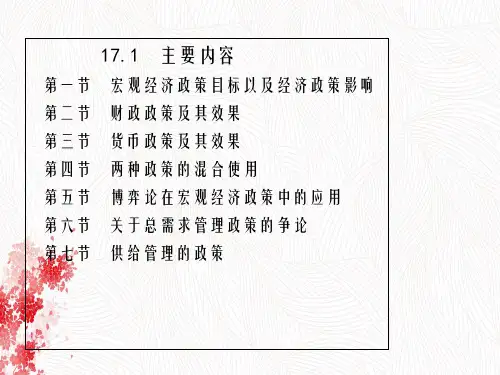

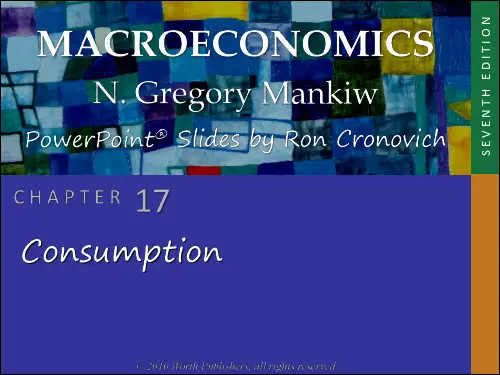
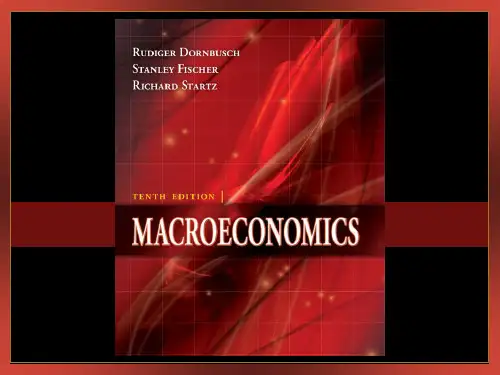

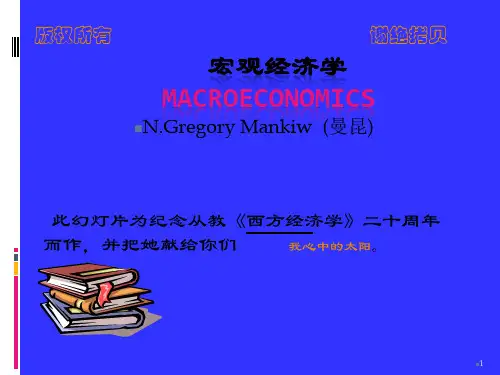

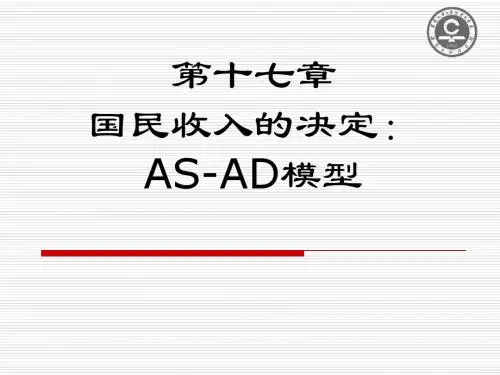


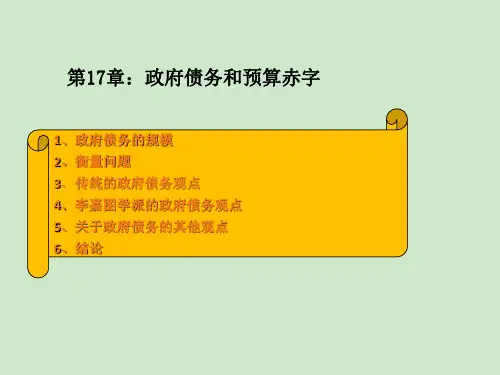
第6篇 再论支撑宏观经济学的微观经济学第17章 消 费跨考网独家整理最全经济学考研真题,经济学考研课后习题解析资料库,您可以在这里查阅历年经济学考研真题,经济学考研课后习题,经济学考研参考书等内容,更有跨考考研历年辅导的经济学学哥学姐的经济学考研经验,从前辈中获得的经验对初学者来说是宝贵的财富,这或许能帮你少走弯路,躲开一些陷阱。
以下内容为跨考网独家整理,如您还需更多考研资料,可选择经济学一对一在线咨询进行咨询。
一、判断题1.长期消费函数比短期消费函数更陡峭。
()【答案】T【解析】短期消费函数有下降的平均消费倾向,长期消费函数有不变的平均消费倾向。
2.贫富差距的拉大不利于提高社会的总收入水平。
()【答案】T【解析】一般说来穷者消费倾向高,富者消费倾向低,倘若贫富差距拉大,会降低整个社会的消费倾向,消费减少,社会总收入水平下降。
3.按随机游走理论,消费的变动就是不可预期的。
( )【答案】T【解析】根据随机游走理论,消费者面临波动的收入并尽最大努力在不同时期平滑消费,在任何时刻,消费者根据现在对一生收入的预期进行选择,消费的变动反映了一生收入的“意外变动”,消费者只对那些完全不可预期的事件感到意外,因此消费的变动是不可预期的。
4.持久收入较高的家庭有同比例较高的消费,因此高收入家庭平均消费倾向较高。
( )【答案】F【解析】持久收入较高的家庭平均消费倾向/P APC Y Y α=,高收入家庭的平均消费倾向更低,持久收入较高的家庭有同比例较高的消费。
5.可以用消费的生命周期假说解释短期边际消费倾向高、长期边际消费倾向低的现象。
( )【答案】T【解析】在长期中,财产与可支配收入的比率大致是不变的,可支配收入中劳动收入的比率也是大致不变的,因此,长期平均消费倾向是稳定的,边际消费倾向与平均消费倾向大致相等。
但在短期中,财产与可支配收入的比率是变动的,其原因主要是资本市场的价格变动,因此短期边际消费倾向较高。
曼昆《宏观经济学》(第6、7版)第6篇再论支撑宏观经济学的微观经济学第17章消费复习笔记跨考网独家整理最全经济学考研真题,经济学考研课后习题解析资料库,您可以在这里查阅历年经济学考研真题,经济学考研课后习题,经济学考研参考书等内容,更有跨考考研历年辅导的经济学学哥学姐的经济学考研经验,从前辈中获得的经验对初学者来说是宝贵的财富,这或许能帮你少走弯路,躲开一些陷阱。
以下内容为跨考网独家整理,如您还需更多考研资料,可选择经济学一对一在线咨询进行咨询。
消费决策对短期和长期经济分析都有至关重要的作用。
在美国等发达国家,消费占GDP 的三分之二,在短期,消费的波动是经济繁荣和衰退的关键因素,边际消费倾向还会影响财政政策的效果。
在长期,消费影响经济的储蓄率,决定长期稳定状态的资本存量和产出水平。
但是,经济学家对消费者行为并没有一个统一的解释,本章介绍六位著名经济学家的消费理论。
1.凯恩斯的消费函数(1)凯恩斯关于消费函数的三个猜测①边际消费倾向在0~1之间;②平均消费倾向随着收入的增加而下降;③收入是决定消费的主要因素,认为利率对消费的影响不大。
(2)消费函数根据以上三个猜测,凯恩斯的消费函数通常表示为:=+C C cY式中,0C>,是固定水平的“主动消费”;Y是可支配收入;c是边际消费倾向,01<<。
c如图17-1所示,边际消费倾向MPC是消费函数的斜率,平均消费倾向/APC C Y=等于从原点到消费函数上的一点的直线的斜率。
图17-1 凯恩斯消费函数二战后的经验数据表明,凯恩斯关于平均消费倾向随收入的增加而下降的猜测与现实经济运行情况并不吻合。
经济学家库兹涅茨通过对实际经济数据的研究发现,从一个10年到另一个10年,消费与收入的比率是稳定的,这就是“消费函数之谜”。
也就是说,短期消费函数和长期消费函数是不一样的。
短期消费函数有下降的平均消费倾向,长期消费函数有不变的平均消费倾向。
凯恩斯主义消费函数类似短期消费函数。
Note that C′is greater than C,and T1′is greater than T1, as shown. This is because in part (b), the consumer has lower consumption in the first part of life, so there are more resources left when there is no constraint—consumption will be higher. The case where people are borrowing constrained in their early working years is more realistic since it is difficult, if not impossible, to borrow against expected future income.6.The life-cycle model predicts that an important source of saving is that people savewhile they work to finance consumption after they retire. That is, the young save, and the old dissave. If the fraction of the population that is elderly will increase over the next 20 years, the life-cycle model predicts that as these elderly retire, they will begin to dissave their accumulated wealth in order to finance their retirement consumption: thus, the national saving rate should fall over the next 20 years.7.In this chapter, we discussed two explanations for why the elderly do not dissave asrapidly as the life-cycle model predicts. First, because of the possibility of unpredictable and costly events, they may keep some precautionary saving as a buffer in case they live longer than expected or have large medical bills. Second, they may want to leave bequests to their children, relatives, or charities, so again, they do not dissave all of their wealth during retirement.If the elderly who do not have children dissave at the same rate as the elderly who do have children, this seems to imply that the reason for low dissaving is the precau-tionary motive; the bequest motive is presumably stronger for people who have children than for those who don’t.An alternative interpretation is that perhaps having children does not increase desired saving. For example, having children raises the bequest motive, but it may also lower the precautionary motive: you can rely on your children in case of financial emer-gency. Perhaps the two effects on saving cancel each other.8.If you are a fully rational and time-consistent consumer, you would certainly prefer thesaving account that lets you take the money out on demand. After all, you get the same return on that account, but in unexpected circumstances (e.g., if you suffer an unex-pected, temporary decline in income), you can use the funds in the account to finance your consumption. This is the kind of consumer in the intertemporal models of Irving Fisher, Franco Modigliani, and Milton Friedman.By contrast, if you face the “pull of instant gratification,” you may prefer the account that requires a 30-day notification before withdrawals. In this way, you pre-commit yourself to not using the funds to satisfy a desire for instant gratification. This precommitment offers a way to overcome the time-inconsistency problem. That is, some people would like to save more, but at any particular moment, they face such a strong desire for instant gratification that they always choose to consume rather than save. This is the type of consumer in David Laibson’s theory.。
宏观经济学讲稿第一篇宏观经济变量第一章总产出一、总产出核算的指标1.国民生产总值和国内生产总值(1)国民生产总值(GNP):指一个国家或地区一定时期内由本地公民所生产的全部最终产品和劳务的价格总和。
GNP在统计时必须注意以下原则:第一,GNP统计的是最终产品,而不是中间产品。
最终产品供人们直接使用和消费,不再转卖的产品和劳务。
中间产品作为生产投入品,不能直接使用和消费的产品和劳务。
第二,GNP是流量而非存量。
流量是指一定时期内发生或产生的变量。
存量是指某一时点上观测或测量到的变量。
第三,GNP按国民原则,而不按国土原则计算。
(2)国内生产总值(GDP):指一定时期内在一个国家或地区范围内所生产的全部最终产品和劳务的价格总和。
GDP与GNP的关系是:GNP--本国公民在国外生产的最终产品和劳务的价格GDP=GNP+外国公民在本国生产的最终产品和劳务的价格2.国民生产净值与国内生产净值国民生产净值(NNP)与国内生产净值(NDP):GNP或GDP扣除折旧以后的余额。
它们是一个国家或地区一定时期内财富存量新增加的部分。
3.国民收入(NI):NNP或NDP扣除间接税后的余额。
它入体现了一个国家或地区一定时期内生产要素收入,即工资、利息、租金和利润的总和。
间接税指能够转嫁税负即可以通过提高商品和劳务的售价把税负转嫁给购买者的税收。
这类税收一般在生产和流通环节征收,如增值税、营业税、关税等。
直接税指不能转嫁税负即只能由纳税人自己承担税负的税收。
这类税收一般在收入环节征收,如所得税。
4.个人收入(PI):一个国家或地区一定时期内个人所得的全部收入。
它是国民收入进一些必要的调整后形成的一个指标。
最主要的扣减项有:公司未分配利润、社会保障支付;最主要的增加项有:政府对个人的转移支付,如失业救济、退休金、医疗补助等。
5.个人可支配收入(D P I):个人收入扣除所得税以后的余额。
国民经济核算体系(SNA)各级指标之间的关系是:GNP或GDP减折旧;等于——NNP或NDP减间接税;等于——NI减公司未分配利润、社会保障支付;加转移支付;等于——PI减个人所得税;等于——DPI二、总产出核算的方法1.收入法:把一个国家或地区一定时期内所有个人和部门的收入进行汇总。